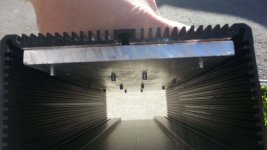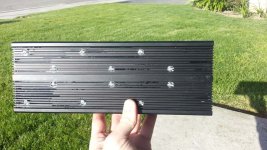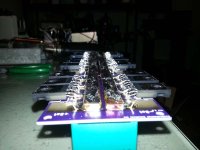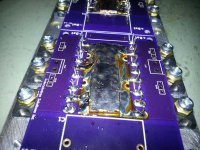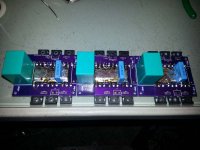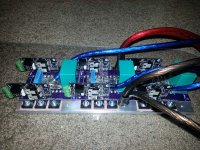zombiess
10 MW
This is a new layout I've been working on so I don't have to use a shoebox sized case. This one is also more powerful as it utilized 3 parallel IRFP4568's. Current sensors will be HASS 600A units. I'm now working to scale down the Lebowski controller board so it will fit in the case below these boards.
The phase output boards are individual. Masking has been removed from the top and bottom layer in the proper location so that I can run 0.375 wide 0.125 thick copper buss bar for the bat+ and batt- connections. The FETs are mounted face down and will be attached to a 3.5" wide 10" aluminum bar stock which then attaches to a Hammond 431623 enclosure which is 11.2" long. Phase output connections will be made by surface mounting 8 gauge wire to the bottom board, 2 strands if needed.
I'm not 100% sure if I should keep a G-S cap/resistor on each MOSFET or just run one single one right off the gate input. I like the idea of having just one G-S cap and one G-S resistor vs putting them on each MOSFET.
Battery connections will be made towards the center of the buss by the capacitor. I am extending out some of the copper buss bar and soldering the wire to it, probably 4 gauge. All the polypropylene caps are mounted on the bottom side of the board.
The gate driver boards are mounted at a 90 degree angle to the main power board and then attached by two 3 pin 90 degree headers which make electrical and mechanical connections. This is why the driver boards are mirrored the way they are, keeping everything symmetrical.
This is not final yet, but it's getting close unless I hit a show stopper. I need to get my first controller on my bike and riding, but this is following close behind as the other controller is just way too big for practical usage.
This design will be open source, but it's lacking the proper documentation right now. It's the same basic gate design as the original power stage I built and most of the components have the same numbers so the document in that describes many of the component functions. I also have a spreadsheet which helps you calculate the desaturation, timing and 2 level turn off components. This is going to take a while to document, but I wanted to put it up here and get some input / reviews.
You will need to have KiCad installed to look at the files. Some of them have a lot of layers and it's going to be the best way to examine the work so you can turn them on/off as needed. The output stage has 2 internal layers to create a laminated power buss, the internal layers don't carry much current.
I'll probably think of more, it's late.
Gate driver with 15A boost stage, 2 layer board
KiCad files View attachment 1
View attachment Driver With Boost V2 Schematic.pdf
View attachment 4
18 FET H Bridge, single phase, 3 required, 4 layer board
KiCad files View attachment One Phase.zip

The phase output boards are individual. Masking has been removed from the top and bottom layer in the proper location so that I can run 0.375 wide 0.125 thick copper buss bar for the bat+ and batt- connections. The FETs are mounted face down and will be attached to a 3.5" wide 10" aluminum bar stock which then attaches to a Hammond 431623 enclosure which is 11.2" long. Phase output connections will be made by surface mounting 8 gauge wire to the bottom board, 2 strands if needed.
I'm not 100% sure if I should keep a G-S cap/resistor on each MOSFET or just run one single one right off the gate input. I like the idea of having just one G-S cap and one G-S resistor vs putting them on each MOSFET.
Battery connections will be made towards the center of the buss by the capacitor. I am extending out some of the copper buss bar and soldering the wire to it, probably 4 gauge. All the polypropylene caps are mounted on the bottom side of the board.
The gate driver boards are mounted at a 90 degree angle to the main power board and then attached by two 3 pin 90 degree headers which make electrical and mechanical connections. This is why the driver boards are mirrored the way they are, keeping everything symmetrical.
This is not final yet, but it's getting close unless I hit a show stopper. I need to get my first controller on my bike and riding, but this is following close behind as the other controller is just way too big for practical usage.
This design will be open source, but it's lacking the proper documentation right now. It's the same basic gate design as the original power stage I built and most of the components have the same numbers so the document in that describes many of the component functions. I also have a spreadsheet which helps you calculate the desaturation, timing and 2 level turn off components. This is going to take a while to document, but I wanted to put it up here and get some input / reviews.
You will need to have KiCad installed to look at the files. Some of them have a lot of layers and it's going to be the best way to examine the work so you can turn them on/off as needed. The output stage has 2 internal layers to create a laminated power buss, the internal layers don't carry much current.
I'll probably think of more, it's late.
Gate driver with 15A boost stage, 2 layer board
KiCad files View attachment 1
View attachment Driver With Boost V2 Schematic.pdf
View attachment 4
18 FET H Bridge, single phase, 3 required, 4 layer board
KiCad files View attachment One Phase.zip




